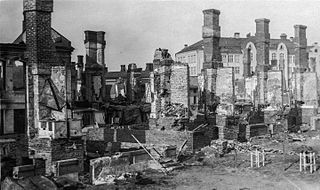
The Finnish Civil War was a civil war in Finland in 1918 fought for the leadership and control of the country between White Finland and the Finnish Socialist Workers' Republic during the country's transition from a grand duchy ruled by the Russian Empire to a fully independent state. The clashes took place in the context of the national, political, and social turmoil caused by World War I in Europe. The war was fought between the Red Guards, led by a section of the Social Democratic Party, and the White Guards, conducted by the senate and those who opposed socialism with assistance late in the war by the German Imperial Army at the request of the Finnish civil government. The paramilitary Red Guards, which were composed of industrial and agrarian workers, controlled the cities and industrial centres of southern Finland. The paramilitary White Guards, which consisted of land owners and those in the middle and upper classes, controlled rural central and northern Finland, and were led by General C. G. E. Mannerheim.

Three Comrades is a 1936 novel by the German author Erich Maria Remarque. It is written in first person by the main character Robert Lohkamp, whose somewhat disillusioned outlook on life is due to his horrifying experiences in the trenches of the First World War's French-German front. He shares these experiences with Otto Köster and Gottfried Lenz, his two comrades with whom he runs an auto-repair shop in what may be late-1920s Hamburg. Remarque wrote the novel in exile and it was first published in the Danish translation; the English translation followed soon, being serialised in Good Housekeeping from January to March 1937, and in the book form later in the year. The first German language edition was published in 1938 by Exilliteratur publisher Querido in Amsterdam, but the novel was published in Germany only in 1951.
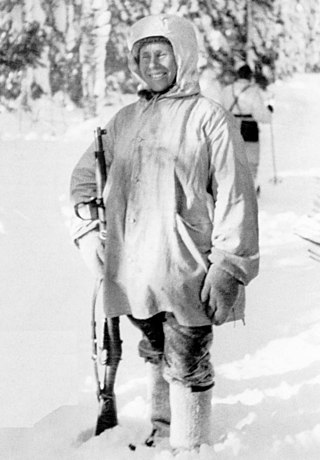
Simo Häyhä, often referred to by his nickname The White Death, was a Finnish military sniper during World War II in the 1939–1940 Winter War between Finland and the Soviet Union. He used a Finnish-produced M/28-30 rifle and a Suomi KP/-31 submachine gun. Häyhä is believed to have killed over 500 enemy soldiers during the conflict, the highest number of sniper kills in any major war. Consequently, he is often regarded as the deadliest sniper in history.
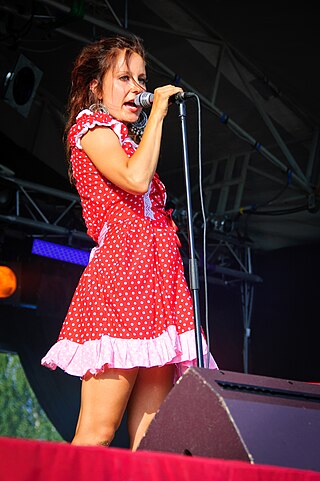
Mariska is a Finnish rapper, singer and songwriter. She writes her songs by herself, and the lyrics often deal with relationships, male chauvinism and politics.

Karl Harald Wiik was a Swedish-speaking Finnish Social Democratic (SDP) leader. Elected to parliament numerous times between 1911 and the time of his death and Secretary of the SDP for more than a decade, Wiik is remembered as one of six radical SDP members of parliament expelled from the SDP in the aftermath of the Winter War with the Soviet Union.
Aapo was a 1994 Finnish film directed by Tero Jartti and based on a short story by Runar Schildt. The screenplay was written by Jari Hietanen. The film was set in the year 1918. Taisto Reimaluoto portrayed Aapo.

Ernst Runar Schildt was a Swedish-speaking Finnish author from Helsinki. His son was art historian and author Göran Schildt. Although Schildt wrote his books in Swedish, they have also been translated into Finnish, English, French and German.

Uuno Kailas, born Frans Uno Salonen was a Finnish poet, writer, and translator. Together with Kaarlo Sarkia, Kailas was the most prominent Finnish poet of the 1930s.

Benno Alexander "Santeri" Levas was a Finnish writer and photographer, best known for his books on the composer Jean Sibelius.

Hans Kalm was an Estonian soldier who served in the armies of Russian Empire, Finland and Estonia. He was also a homeopath and naturopath who took an interest in alternative medicine.

Nyrki Tapiovaara, born 10 September 1911 in Pitäjänmäki, Helsinki, died 29 February 1940, was a Finnish film director. He belonged to the Tulenkantajat group which promoted modernist ideas in Finnish culture. Tapiovaara's film career only lasted four years and resulted in five feature films, but had a lasting effect on Finnish cinema. He died in the Winter War.

Tor Börje Lampenius was a Finnish actor, director and singer. He made an extensive career in the Swedish Theatre in Helsinki. His most notable roles included the lead role in Death of a Salesman and the role of Freddy in the Finnish version of the musical My Fair Lady. Lampenius has recorded a number of hits and starred in movies both in Finland and in Sweden. In 2000, Lampenius was granted, by the Organization of Finnish Theatres, the Badge of the Golden Federation.
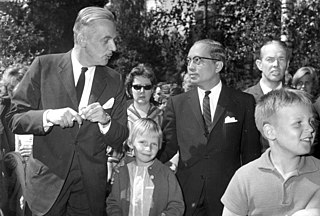
Carl Fredrik Ralph Alexander Enckell was a Finnish diplomat.
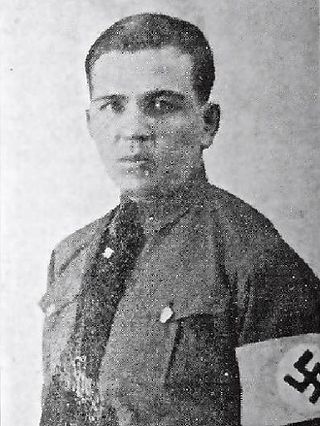
Hjalmar Thorvald Oljemark was a Finnish manor owner and a Nazi. He was one of the founders of the Nazi party called the Finnish People's Organisation and also worked as its propaganda chief and editor-in-chief of the party's newspapers.

Arvi Kalsta was a Finnish Jaeger captain, the founder of the Nazi Finnish People's Organisation and a businessman. In the 1930s, the Finnish Nazis who belonged to his supporters were called Kalstaites.

Martti Aleksander Pihkala was a National Coalition Party MP who became known as a Jäger activist, Ostrobothnia White Guard founder, in the 1920s and 1930s, leader of the strikebreaking organisation Vientirauha, also known as "Pihkala's Guard" and an influencer of the Lapua movement and the Patriotic People's Movement.

Johan Christian Sergei Fabritius was a Finnish military lieutenant colonel.

Vietti Brynolf Nykänen was a Finnish architect, writer and politician.

Göran Schildt was a Finnish Swede author and art historian. He was the son of the author Runar Schildt.

Johan Ulfstjerna is a 1936 Swedish drama film directed as well as co-written by Gustaf Edgren and starring Gösta Ekman, Björn Berglund and Birgit Tengroth. It is based on the 1907 Tor Hedberg play Johan Ulfstjerna, which had previously been made into a 1923 silent film of the same title. It was shot at the Råsunda Studios in Stockholm. The film's sets were designed by the art director Arne Åkermark.


















